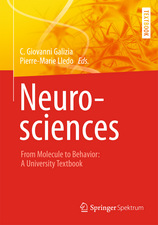Receptors in the Evolution and Development of the Brain: Matter into Mind
Autor Richard E. Fineen Limba Engleză Paperback – 17 iun 2019
- Provides an understanding of the key role receptors play in brain development and the selection process necessary to construct a large brain
- Traces the evolution of receptors from the most primitive organisms to humans
- Emphasizes the roles that REM sleep and apoptosis play in this selection via trophic factors and receptors
- Describes the role that trophic factor-receptor interactions play throughout life and how trophic deficits can lead to connectional diseases, including Alzheimer's, Parkinson's and ALS
- Provides a potential mechanism whereby neuronal stem cells can cure these diseases
Preț: 487.73 lei
Preț vechi: 607.64 lei
-20% Nou
93.36€ • 101.44$ • 78.47£
Carte tipărită la comandă
Livrare economică 14-28 aprilie
Specificații
ISBN-10: 0128110120
Pagini: 282
Dimensiuni: 191 x 235 x 16 mm
Greutate: 0.61 kg
Editura: ELSEVIER SCIENCE
Public țintă
Graduate students in biological and biomedical sciences, neuroscientists, neurobiologists, post-doctoral fellows, biomedical researchers, radiologistsCuprins
1. Classes of Receptors, Their Signaling Pathways and Their Synthesis and Transport 2. The RNA World and Roles of Receptors and Their Cognate Ligands in Archaea, Bacteria and Choanoflagellates; the latter being the Ancestor of all Eukaryotes 3. Dictyostelium Discoideum: Role of Receptors in Differentiation. Sponges are Among the Earliest Multicellular Animals while Comb Jellies are Thought to be Closest to the Ancestral Nerve Cell Containing Animal. Hydras are Among the Earliest Animals with a True Nervous System 4. The Growth Cone; the Key Organelle in the Steering of the Neuronal Processes; The Synapse; Role in Neurotransmitter Release 5. Neuronal Cell Biology 6. Glial Cells; The Evolution of the Myelinated Axon; Blood Brain Barrier (BBB) 7. A Testable Theory to Explain How the Wiring of the Brain Occurs 8. The Development of the Cerebral Cortex 9. The Importance of Rapid Eye Movement (REM) Sleep and Other Forms of Sleep in Selecting the Appropriate Neuronal Circuitry; Programmed Cell Death/Apoptosis 10. The Key Roles of BDNF and Endocannabinoids at Various Stages of Brain Development Including Neuronal Commitment, Migration and Synaptogenesis 11. The Key Roles of Axon and Dendrite Guidance Molecules and the Extracellular Matrix in All Stages of Brain Development 12. Key Receptors involved in Laminar and Terminal Specification and Synapse Construction 13. Steroid Hormones and their Receptors are Key to Sexual Differentiation of the Brain while Glucocorticoids and their Receptors are Key Components of Brain Development and Stress Tolerance; The Hypothalamic Hormone Producing Cells: Importance in Various Functions During and After Brain Development 14. The Roles of Receptors and Trophic Factors in the Development of the Enteric Nervous System (ENT) and in the Connections between Viruses, the Microbiota, (ENT) and Brain 15. Synaptic Pruning During Development and Throughout Life Depends on Trophic Factor Interactions: The Corollary Described in Chapter 14, Postulating the Quantization of Trophic Factor Requirements, Provides a Plausible Explanation for the Survival of Neurons Partially Deprived of their Full Complement of Trophic Factors 16. Receptor Mediated Mechanisms for Drugs of Abuse which may Adversely Affect Brain Development 17. Role of Trophic Factors and Receptors in Developmental Brain Disorders 18. Trophic Factor-Receptor Interactions which Mediate Neuronal Survival can in Some Cases Last Through Life, and Trophic Deficits can Produce Connectional Neurodegenerative Diseases 19. Potential Use of Neuronal Stem Cells to Replace Dying Neurons Depends on Trophic Factors and Receptors 20. The Key Roles of Axon and Dendrite Guidance Molecules and the Extracellular Matrix in All Stages of Brain Development
Descriere
Receptors in the Evolution and Development of the Brain: Matter into Mind presents the key role of receptors and their cognate ligands in wiring the mammalian brain from an evolutionary developmental biology perspective. It examines receptor function in the evolution and development of the nervous system in the large vertebrate brain, and discusses rapid eye movement sleep and apoptosis as mechanisms to destroy miswired neurons. Possible links between trophic deficits and connectional diseases including Alzheimer’s, Parkinson’s, and ALS are also discussed. This book is extremely useful to those with an interest in the molecular and cellular neurosciences, including those in cognitive and clinical branches of this subject, and anyone interested in how the incredibly complex human brain can build itself.
- Provides an understanding of the key role receptors play in brain development and the selection process necessary to construct a large brain
- Traces the evolution of receptors from the most primitive organisms to humans
- Emphasizes the roles that REM sleep and apoptosis play in this selection via trophic factors and receptors
- Describes the role that trophic factor-receptor interactions play throughout life and how trophic deficits can lead to connectional diseases, including Alzheimer's, Parkinson's and ALS
- Provides a potential mechanism whereby neuronal stem cells can cure these diseases


























